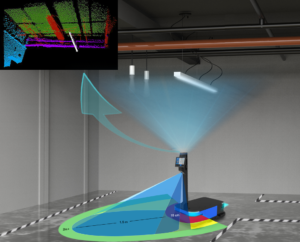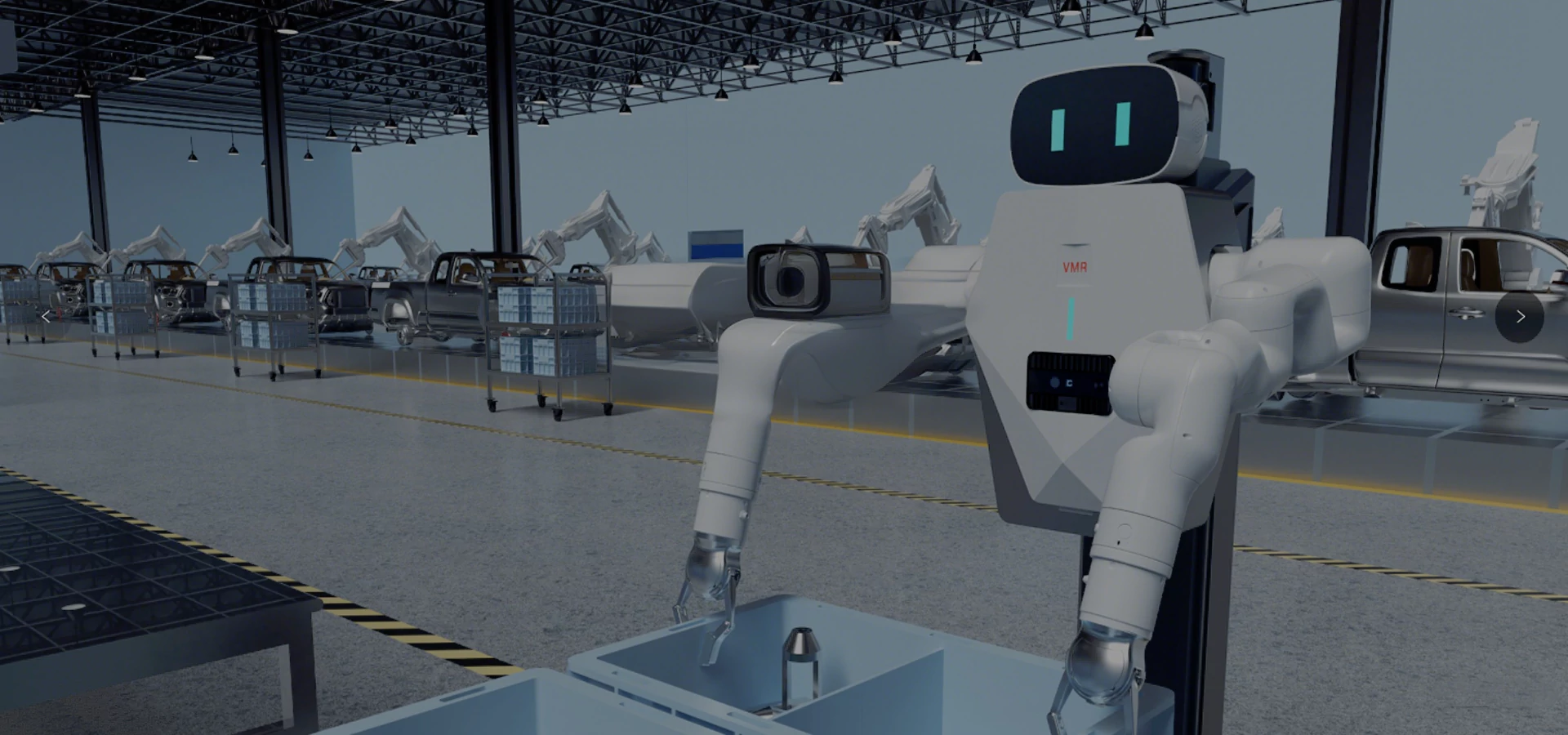Indoor navigation remains a complex challenge for autonomous robots and devices, especially in environments where GPS signals are weak or nonexistent. Traditional navigation methods often struggle with accuracy and obstacle detection, limiting the efficiency and reliability of mobile systems. This is where
Ceiling Vision SLAM (CV-SLAM) comes in — a cutting-edge technology that leverages ceiling-mounted cameras and advanced mapping algorithms to provide precise, real-time localization and navigation indoors. In this blog, we’ll explore what CV-SLAM is, how it works, and why it’s becoming an essential tool for improving navigation in warehouses, factories, drones, and other GPS-denied environments.
Understanding CV-SLAM: What It Is and How It Works
Ceiling Vision SLAM (CV-SLAM) is an innovative indoor navigation technology that uses ceiling-mounted cameras to help robots and autonomous systems localize themselves and build accurate maps of their environment. Unlike traditional SLAM methods that rely on sensors placed near the floor, CV-SLAM captures visual and depth data from above, providing a clearer and more stable perspective of the space. By tracking unique ceiling features such as lighting fixtures or structural patterns, CV-SLAM can precisely determine a robot’s position even in complex indoor environments.
This overhead vision approach offers significant advantages, especially in cluttered or dynamic settings where floor-level sensors may be obstructed by moving objects. Since ceilings are usually free of obstacles, the system gathers less noisy data, resulting in more reliable mapping and improved
obstacle avoidance. CV-SLAM is particularly valuable in GPS-denied indoor areas like warehouses, factories, and hospitals, enabling smoother, more efficient navigation for autonomous robots and drones.
How CV-SLAM Boosts Indoor Navigation Accuracy
MRDVS’s advanced ceiling-mounted vision systems empower CV-SLAM technology to deliver highly accurate indoor navigation, overcoming traditional challenges in complex and dynamic environments.
-
Stable Overhead Perspective
By mounting cameras on the ceiling, CV-SLAM provides a consistent, unobstructed view of the environment. Unlike floor-level sensors, which can be blocked by furniture, people, or moving objects, ceiling-mounted vision systems maintain a clear line of sight, reducing data noise and improving the accuracy of position tracking.
-
Precise Feature Detection
CV-SLAM leverages distinct and stable features found on ceilings—such as lighting fixtures, vents, or structural patterns—as reliable reference points. These features remain fixed and less prone to change, enabling the system to consistently recognize and track the robot’s location with high precision.
-
Reduced Dynamic Interference
Indoor environments are often filled with moving obstacles that can confuse floor-based navigation systems. Since ceilings rarely experience movement, CV-SLAM minimizes the impact of dynamic interference, allowing more reliable mapping and localization.
-
Enhanced Depth Perception
Using
RGB-D or depth cameras, CV-SLAM collects both color and depth information, enabling a detailed 3D reconstruction of the surroundings. This richer data helps the system better understand spatial relationships and improves obstacle detection and avoidance, leading to safer and more efficient navigation.
How CV-SLAM is Revolutionizing Navigation in GPS-Denied Spaces
Indoor environments like warehouses, hospitals, factories, and underground facilities often lack reliable GPS signals, which makes navigation systems struggle. Traditional floor-based sensors can be obstructed by dynamic objects—people, equipment, or even narrow hallways—resulting in inaccurate localization.
A Clearer, More Stable View
CV-SLAM (Ceiling Vision SLAM) solves this problem by using ceiling-mounted cameras. This overhead perspective provides a consistent, unobstructed view of the space, which is free from the common disruptions faced by ground-level sensors.
Accurate Localization Without GPS
By focusing on fixed ceiling features like lights, beams, and vents, CV-SLAM allows robots to precisely track their position in real time. This enables indoor navigation even in places where GPS signals are unavailable, ensuring continuous and reliable movement through complex environments.
Ideal for Large-Scale, Dynamic Environments
With CV-SLAM, large and dynamic facilities can rely on precise, real-time navigation. From guiding robots through vast warehouses to automating tasks in hospitals, this technology makes indoor autonomy more reliable and adaptable, even in changing environments.
Comparing CV-SLAM vs Floor SLAM: Pros & Cons
When choosing the right SLAM technology for indoor navigation, understanding the differences between Ceiling Vision SLAM (CV-SLAM) and traditional floor-based SLAM is essential. The table below highlights the key pros and cons of each approach to help you decide which best fits your application needs.
|
Feature
|
CV-SLAM (Ceiling Vision SLAM)
|
Traditional Floor-Based SLAM
|
|
Sensor Placement
|
Ceiling-mounted cameras provide an overhead view
|
Sensors positioned near the floor or on the robot
|
|
Field of View
|
Offers a broad, unobstructed perspective of the area
|
Often limited by obstacles and moving objects
|
|
Obstacle Interference
|
Minimal interference since ceilings are typically clear
|
Higher interference due to people, furniture, and dynamic objects on the floor
|
|
Feature Stability
|
Tracks stable ceiling features like lights and beams
|
Floor features can change frequently (e.g., furniture rearranged)
|
|
Navigation Accuracy
|
High accuracy due to consistent vantage point
|
Accuracy can degrade in cluttered or dynamic spaces
|
|
Suitability for GPS-Denied Areas
|
Excellent for indoor GPS-denied environments
|
Also used indoors but may suffer from occlusion issues
|
|
Hardware Complexity
|
Requires ceiling installation and infrastructure
|
Generally easier to deploy, sensors onboard robot
|
|
Cost Considerations
|
Potentially higher initial setup costs
|
Lower upfront costs but may require more maintenance
|
Why CV-SLAM is Crucial for Indoor Navigation
CV-SLAM offers unique advantages that make it especially valuable for navigating indoor spaces where traditional methods often fall short:
-
Bypasses GPS Limitations: CV-SLAM works effectively in GPS-denied environments like warehouses, factories, and hospitals, providing continuous and accurate localization.
-
Minimizes Visual Interference: Ceiling-mounted cameras avoid the clutter and movement found at ground level, resulting in cleaner visual input for mapping and tracking.
-
Enhances Navigation Accuracy: By using stable ceiling features (like lighting and beams) as reference points, CV-SLAM ensures more consistent positioning and route planning.
-
Improves Obstacle Avoidance: The overhead perspective helps robots anticipate and avoid obstacles with greater precision, even in dynamic or crowded spaces.
-
Boosts Efficiency in Tight Layouts: CV-SLAM is ideal for confined indoor environments, enabling smooth and reliable navigation in areas with narrow aisles or frequent layout changes.

How MRDVS Supports CV-SLAM Technology
MRDVS plays a pivotal role in advancing CV-SLAM systems through its high-performance RGB-D vision cameras designed specifically for mobile and ceiling-mounted applications. With precise depth sensing, wide field of view, and robust industrial-grade design, MRDVS cameras deliver the critical visual data needed for accurate mapping and localization.
Optimized for Overhead Installation: MRDVS cameras such as the M4 Mega and S2 Max are ideal for ceiling-mount use, providing a stable top-down view that enhances CV-SLAM’s performance in complex indoor settings.
High-Precision Depth Sensing: Equipped with cutting-edge sensors like the Sony IMX570 iToF, MRDVS cameras offer reliable depth perception even in low-light or high-contrast environments, crucial for 3D mapping accuracy.
Wide Field of View (FOV): These cameras capture a broad visual range, allowing the system to detect ceiling features more effectively and support smooth, uninterrupted localization.
Durability in Industrial Environments: With IP-rated protection and robust design, MRDVS cameras withstand harsh indoor conditions, making them suitable for deployment in warehouses, factories, and logistics hubs.
Seamless Integration with CV-SLAM Algorithms: MRDVS provides consistent and high-quality RGB-D data streams, ensuring compatibility with advanced CV-SLAM algorithms and real-time processing requirements.
By supplying advanced vision hardware tailored to CV-SLAM needs, MRDVS empowers developers and integrators to build more accurate, efficient, and scalable indoor navigation systems.
Conclusion
Ceiling Vision SLAM (CV-SLAM) is transforming indoor navigation by offering a more stable, accurate, and interference-free approach to mapping and localization. Its overhead perspective, paired with powerful RGB-D vision systems, enables autonomous robots to operate more efficiently in complex, GPS-denied environments. As demand for smarter indoor mobility grows, CV-SLAM will play an increasingly vital role in robotics and automation.
Ready to enhance your navigation systems with advanced ceiling-mounted vision? Explore MRDVS’s high-performance RGB-D cameras and see how our technology can elevate your CV-SLAM applications to the next level.

-291x300.jpg)
